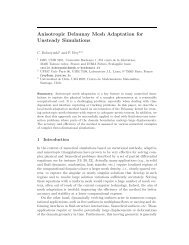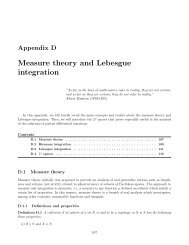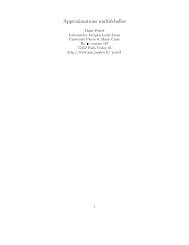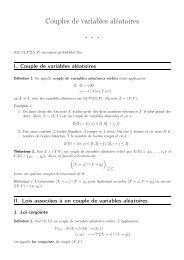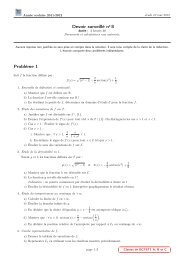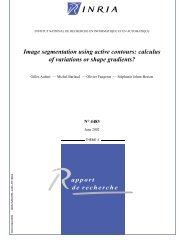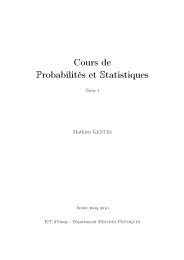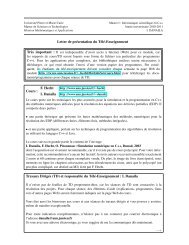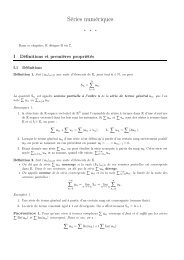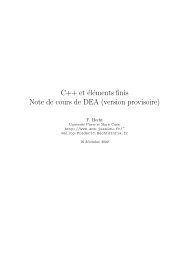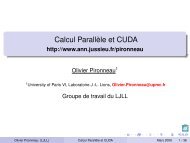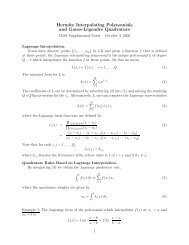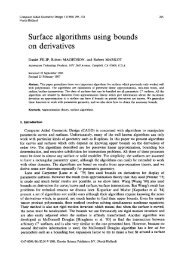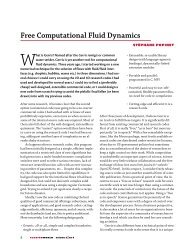pdf file
pdf file
pdf file
Create successful ePaper yourself
Turn your PDF publications into a flip-book with our unique Google optimized e-Paper software.
36 M. LEWIN, P. T. NAM, S. SERFATY, AND J. P. SOLOVEJ<br />
In the latter bound, by choosing M = N 1/3 , we get<br />
λL( � HN) ≥ λL(H)−C(εR(N)+N −1/3 ).<br />
Spectral gap. By (i) one has for every L = 1,2,...,<br />
liminf<br />
N→∞ (λL(HN)−λ1(HN)) = λL(H)−λ1(H)<br />
Taking the limit as L → ∞ we obtain the spectral gap<br />
liminf<br />
N→∞ (infσess(HN)−λ1(HN)) ≥ infσess(H)−λ1(H).<br />
Step 2. Convergence of lower eigenvectors. First we consider the conver-<br />
gence of ground states. If ΨN is a ground state of HN, then ΦN := UNΨN<br />
on F≤N + . From the proof in<br />
is a ground state of � HN := UN(HN −NeH)U ∗ N<br />
Step 1, if max{NεR(N), √ N} ≪ M ≪ N, then we have ||gMΦN|| 2 → 0 and<br />
lim<br />
N→∞ 〈fMΦN,HfMΦN〉<br />
�<br />
= λ1(H) = Φ (1) ,HΦ (1)�<br />
where Φ (1) is the unique ground state of H on F+.<br />
To prove ΦN → Φ (1) , it suffices to show that fMΦN → Φ (1) . Let us write<br />
fMΦN = aN +bN<br />
where aN ∈ Span({Φ (1) }) and bN⊥Φ (1) . Then<br />
〈fMΦN,HfMΦN〉 = 〈aN,HaN〉+〈bN,HbN〉 ≥ λ1(H)||aN|| 2 +λ2(H)||bN|| 2<br />
= ||fMΦN|| 2 λ1(H)+(λ2(H)−λ1(H))||bN|| 2 .<br />
Since 〈fMΦN,HfMΦN〉� ΦN − ||fMΦN|| 2 λ1(H) → 0 and λ2(H) > λ1(H), we<br />
conclude that bN → 0 as N → ∞. Therefore, fMΦN → Φ (1) , and hence<br />
ΦN → Φ (1) , as N → ∞.<br />
Remark on the convergence in quadratic domain. We can show that if (A3s)<br />
holds true, then we have the strong convergence ΦN → Φ (1) in the norm inducedbythequadraticformofHonF+,<br />
namely〈ΦN,HΦN〉 → � Φ (1) ,HΦ (1)� .<br />
In fact, from the above proof we already had<br />
〈fMΦN,HfMΦN〉 →<br />
�<br />
Φ (1) ,HΦ (1)�<br />
and<br />
�<br />
gMΦN, � �<br />
HNgMΦN → 0.<br />
On the other hand, from (A3s) and (16), we get � HN ≥ c0(H+N+)+g(N)<br />
on F ≤N<br />
+ , where c0 > 0 and g(N) → 0 as N → ∞. By choosing M such that<br />
max{g(N),NεR(N), √ N} ≪ M ≪ N, we obtain<br />
gM � HNgM ≥ c0(H+M)+g(N) ≥ c0H.<br />
It implies that 〈gMΦN,HgMΦN〉 → 0. By using the localization for H in<br />
Proposition 23 we can conclude that 〈ΦN,HΦN〉 → � Φ (1) ,HΦ (1)� .<br />
Theconvergence of excited states of HN can beproved by usingthe above<br />
argument and the following abstract result.<br />
Lemma 25 (Convergence of approximate eigenvectors). Assume that A is<br />
a self-adjoint operator, which is bounded from below, on a (separable) Hilbert<br />
space, with the min-max values λ1(A) ≤ ... ≤ λL(A) < infσess(A). If the<br />
normalized vectors {x (j)<br />
n } L≥j≥1<br />
n≥1 satisfy, for all i,j ∈ {1,2,...,L},<br />
lim<br />
n→∞ 〈x(i) n ,x(j) n 〉 = δij and lim<br />
n→∞ 〈x(j) n ,Ax(j) n<br />
〉 = λj(A),



